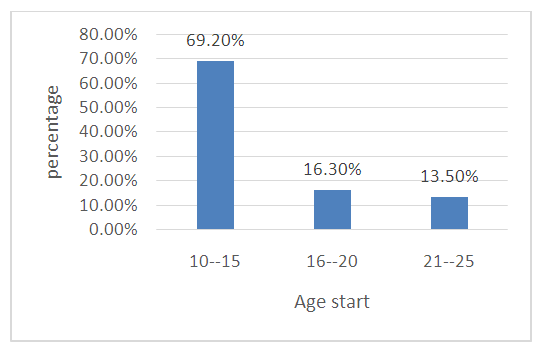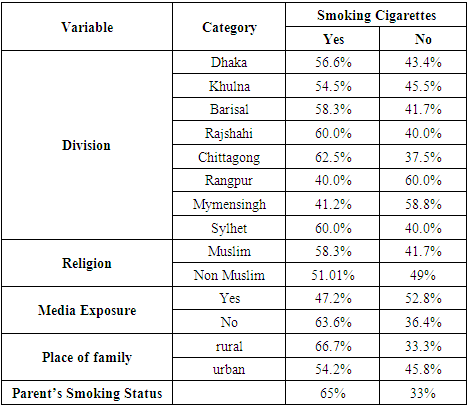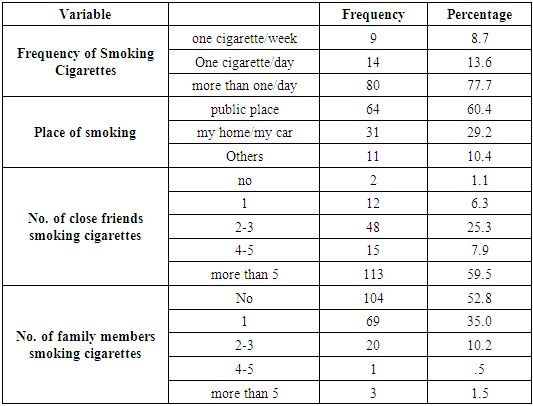-
Paper Information
- Previous Paper
- Paper Submission
-
Journal Information
- About This Journal
- Editorial Board
- Current Issue
- Archive
- Author Guidelines
- Contact Us
International Journal of Statistics and Applications
p-ISSN: 2168-5193 e-ISSN: 2168-5215
2019; 9(6): 186-190
doi:10.5923/j.statistics.20190906.03

Impact of Smoking Cigarettes among University Students of Bangladesh: A Logistic Regression Analysis
Nandita Barman1, Afrin Sadia Rumana2, Md. Nayan Dhali3
1Assistant Professor, Department of ICT, Bangladesh University of Professionals, Bangladesh
2Lecturer, Department of Accounting, Bangladesh University of Professionals, Bangladesh
3Lecturer, Department of Mathematics, Jashore University of Science & Technology, Bangladesh
Correspondence to: Nandita Barman, Assistant Professor, Department of ICT, Bangladesh University of Professionals, Bangladesh.
| Email: |  |
Copyright © 2019 The Author(s). Published by Scientific & Academic Publishing.
This work is licensed under the Creative Commons Attribution International License (CC BY).
http://creativecommons.org/licenses/by/4.0/

University student life is a time when most behavioral personality are being created and fixed. This is the time when students may start smoking by their own interest. Thus, in the present research, Impact and commonness of smoking in university students in Bangladesh has been evaluated. This research also gives concern to explore the factors significantly associated with smoking cigarettes of students in Bangladesh, to identify different demographic and socio-economic factor associated with smoking and to assess the effect of these factors. We will use SPSS, version 20.00 for data analysis. To describe the quantitative and qualitative variables will use descriptive statistics mean, standard deviation and proportion will use Chi-square test and odds ratios observe and measure the association between qualitative study and outcome variables. Logistic regression will use to come into view at the independent risk factors for a dichotomous outcome variable smoking status (Yes/No). 95% confidence intervals will calculate for both crude and adjusted odds ratios. A p-value of less than 0.05 will consider as statistically momentous.
Keywords: Demographic, Socio-economic, Logistic regression
Cite this paper: Nandita Barman, Afrin Sadia Rumana, Md. Nayan Dhali, Impact of Smoking Cigarettes among University Students of Bangladesh: A Logistic Regression Analysis, International Journal of Statistics and Applications, Vol. 9 No. 6, 2019, pp. 186-190. doi: 10.5923/j.statistics.20190906.03.
1. Introduction
- Bangladesh is one of the world's densely populated countries that have a population of about 165 million. A social and financial expansion of a nation depends on the state of health. A health care system imitates the socio-economic and technological development of a country. The usefulness of the health system depends on the convenience and accessibility of services. In health sector there is a problem that has various dimensions and complications for lack of involvement. One of the them is smoking. In Bangladesh smoking is an increasing ubiquitous practice. It is very common among university students also. In the earlier fifteen years, cigarette consumption has more than doubled. Now the third commonest cancer among males and females is Cancer of the lung. Every year more than 12000 peoples die for lung cancer. Respiratory disease is the direct health upshot of smoking. A vital health risk is the reduction in nutritional status of young children that results from spending on smoking in households whose income for food purchase is already marginal [1]. A case study shows that a person who smokes 5 cigarettes in a day in Bangladesh might have regular dietary shortage of 8000 calories. Bangladesh ranked among one of the highest tobacco consuming countries in the world [2]. Every year 57,000 people die each year from tobacco-related sickness. Additionally, university going students who smoke are at amplified risk of a horde of illnesses unswervingly allied with smoking that lead to noteworthy indisposition and impermanence. It is observed that now a day’s students are very much depressed with their educational system as well as their family problem. The number of smokers specially students are increasing continuously. Taking it as a consideration there were not much research has been conducting. It is high time to identify which factors are specially affects our students of being a smoker need to know for taking prevention. Ahmed Mandil, Abdulaziz Bin Saeed et.al. worked on “Smoking among university Students: A gender analysis” [3]. In this paper they said that they tried to find out the outlines of tobacco are among the under graduate students in King Saud University. They took female student as sample and find the threat factors which may subsidize to tobacco use. Population of the research was 69498 both male and female. They took sample as n=7550 students. They took data by using questionnaire. They conduct this study in between 2008-2009. For statistical analysis they used software SPSS version 17.0. Data were examined using proper descriptive, univariate and multivariate statistical tests. To describe the quantitative variables they used mean, standard deviation. Chi-Square test and odds ratios were used to observe and measure the association between quantitative studies and outcome variables. They used Berslow-Day test to 10 cate the effect modification of some of the study variables in relation to the outcome variable. They used logistic regression to decide on at the independent risk furfures for a dichotomous outcome variable something stature. In this research work they worked on 2973male students and 3713 female students. They showed that marital status was single 90% and only 9.2% were married and 0.8% either divorced. They shamed the something the smoking commonness among male students was 32.7.1 and among female students 5.9%. They found high incidence of water pipe consumption among smokers in their study. Junaid Jamshed, Mahammad Mustaqr khan, Zahid Latif worked on “Cigarette smoking habits among university students Prevalence and Associated Factors” [4]. In this research they took 542 male students at University of Azad Jammu and Kashmir. They took data from July to December 2015. Data were collected through questionnaire in English. They collected data from the students of age range 17 to 45 years. They found mean, median of the students age was respectively 22 years and 21 years. They found the standard deviation value was 5.06. The age of first taking of cigarette was among group of 21-25 years. Thus, also found 41.3% students were unmarried 58.1% students were come from urban area. They also found that 59.2% students were from science and engineering faculty. They also found that age marital status and education level were significantly associated with cigarette smoking behavior where P value is less than 0.05. They found that unmarried student had higher prevalence of cigarette smoking that is 51.9% stress assuagement was the most common causes of taking cigarette and it was monitored by smoking friends. Jobran Miree ALQ alhtani worked on “Knowledge, Attitude and Practice of Tobacoo Smoking Among Health Colleges. Students at Najran University, Saudi Arabia, Across- Sectional Descriptive Study” [5]. The research was conducted at Najran University. It was occurred on March 2014. Total sample of this research was 433 students where 226 students were males and 207 students were female. They took data through Pre-tested validated questionnaire Students. They found that 30.1% male and 0.51% females are smoker. They showed that 28.3% of male’s smoker were taking shisha smoking, 16.8% were taking snuff and 14.6% were taking smokers tobacco. Females were very much aware about the harmness of smoking than males Both types of students treasured. Shisha and smokeless tobacco are less harmful. Mean age of males students were 23.6 ± 2.4. The research also found that they preferred coffee shops for taking shisha. They also found that non medical students were smoking higher than medical students. They also found that 70% smokers were smoking almost 10 cigarettes per day. They found that almost half of smokers used to smoking within one hour offer were up in the morning. They also found that 1st year students took smoking in a large number.
2. Research Methodology
- This study focuses on the university students of Bangladesh. Therefore, the population of the current study is the students of public university in Bangladesh. The sampling frame of this study is comprised of the four public universities located in Dhaka division. Dhaka is chosen as the sample frame because of time and cost limitations. Field investigation was made mainly through interview of the various groups of target respondents as mentioned earlier. All the first-hand information was collected through primary inquiries from the field with a view to obtain the information afresh. As our target respondents were university students, we primarily selected 4 public universities (University of Dhaka, Bangladesh University of Professionals, Jahangirnagar University and Jagannath University) in Dhaka division where the university authorities allowed us to collect information. Considering budget and time constrain, we were able to manage data from 200 respondents. Field investigation was made mainly through interview of the various groups of target respondents as mentioned earlier. All the first-hand information was collected through primary inquiries from the field with a view to obtain the information afresh. The questionnaire consisted of two modules – demographic questionnaire and smoking habit related questionnaire [6]. The questionnaire comprises a mix of open-ended and multiple-choice questions, designed at collecting data on the students’ socio demographic characteristics and their smoking behavior. Convenience sampling occurs when a researcher uses the sample to conform to some criteria [7]. This sample technique will be used to collect data from a specific group that is university students of the present study.
3. Data Analysis Techniques
- The current study employed both SPSS (statistical analysis package) version 21 and R programming language for data inserting and analysis. SPSS will be used for data input and other related demographic analysis [8]. Whereas R language will be used for assessing the goodness of the fit of the model. A total of 375 structured questionnaires will be distributed. Data will analyze using suitable descriptive, univariate and multivariate statistical tests. However, by using statistical tools (deciding on confidence / precision level, population size as of date etc.) and also taking above mentioned sampling criteria in to considerations an optimum and representative sample as far as it is possible will be determined [9]. The average age for starting smoking in this study is 19.32 ± 2.37 years. At the age of 16-22 years 59.2% students started their first smoking, 17% ongoing at the age of 12-15 years and as well as 13.5% started their first smoking at the age of 23-28 years.
 | Figure 1. Age for starting cigarette smoking |
|
|
|
 | Figure 2. Graphical analysis of Smoking Cigarettes by Division |
|
 | Figure 3. Reasons for starting cigarette smoking |
|
|
4. Conclusions
- University student life is the time when students may start smoking by their own interest. Thus, in the present research, Impact and commonness of smoking in university students in Bangladesh has been evaluated. This research also gives concern to explore the factors significantly associated with smoking cigarettes of students in Bangladesh, to identify different demographic and socio-economic factor associated with smoking and to assess the effect of these factors. Results of the study exposed that smoking cigarettes was highly influenced by monthly income of family, parental smoking status, media exposure. This research found that among all the independent variables education played a fundamental role on smoking cigarettes. Religion had constructive effect on smoking cigarettes. Among Muslim percentage of smoking cigarettes was highest and lowest among the non-Muslim. Parental smoking status was also a significant factor of smoking cigarettes. Percentage of smoking cigarettes was the highest among the students those parents are or were smoker. We used SPSS, version 20.00 for data analysis. To describe the quantitative and qualitative variables used descriptive statistics mean, standard deviation and proportion will use Chi-square test and odds ratios observe and measure the association between qualitative study and outcome variables. In the result of Chi-Square Tests, it observed that the significance of Pearson Chi-Square value is 0.0001 which was less than .05. So, null hypothesis could be rejected at 5% level of significance, and it could be concluded that, there was an association between smoking cigarettes and family members smoking status.
 Abstract
Abstract Reference
Reference Full-Text PDF
Full-Text PDF Full-text HTML
Full-text HTML




